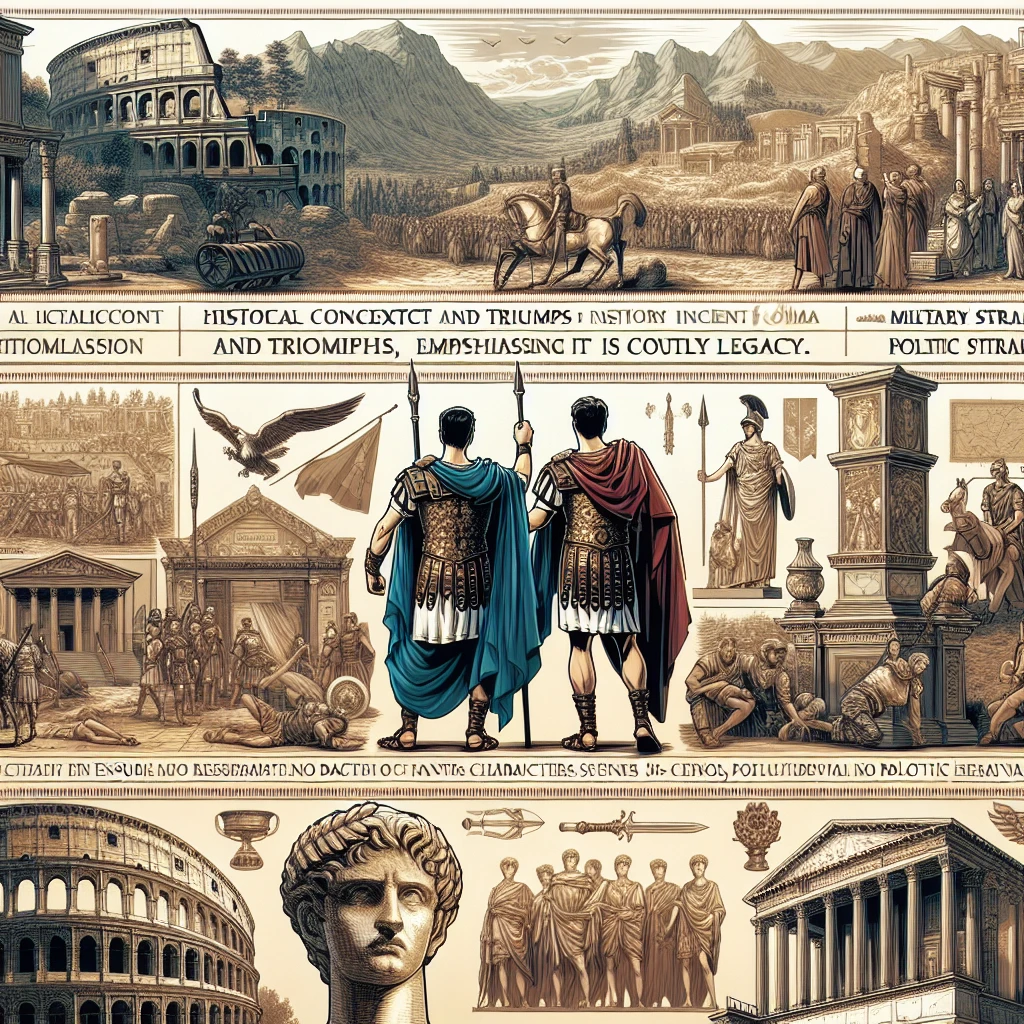[summary]The text is an analysis of HBO’s Rome by historian Tristan Hughes, focusing on the show’s historical accuracy and its impact. Covering Julius Caesar’s rise during the Roman Republic, the series is praised for its authentic depiction of Roman military discipline, attire, and significant historical events, earning the label of a “timeless classic.” However, its commitment to accuracy resulted in a costly production, leading to its cancellation after two seasons despite critical acclaim. The show’s dedication to historical realism distinguished it from other series, enhancing its narrative depth and believability.[/summary]
A Historian’s Perspective on HBO’s Rome: Accuracy and Impact
HBO’s Rome, which aired from 2005 to 2007, has been a subject of fascination for both audiences and historians alike. The series, portraying Julius Caesar’s ascension amidst the waning days of the Roman Republic, featured Ciarán Hinds as Caesar, with Kevin McKidd and Ray Stevenson starring as soldiers Lucius Vorenus and Titus Pullo. As interest in Roman history surges with upcoming releases like Gladiator 2 and Those About To Die, historian Tristan Hughes evaluates the show’s historical fidelity in a special episode of History Hit.
Historical Accuracy in Rome
A Timeless Classic
Tristan Hughes commends Rome for its authenticity, calling it a “timeless classic” beloved by ancient historians. He particularly highlights the show’s attention to detail in depicting Roman legionary discipline and attire, praising the armor as “brilliant.” This meticulous approach effectively captures the essence of Roman military life.
Depictions of Roman Discipline
In his analysis, Hughes delves into the opening battle scenes, underscoring the historical realism portrayed through characters like Vorenus and Pullo. Vorenus’ whistle, though historically insignificant, serves as a narrative device. Meanwhile, Pullo’s punishment for insubordination mirrors actual Roman disciplinary practices, such as crucifixions and public beatings, enriching the series’ educational value.
Historical Events and Details
The series also earns praise for its depiction of significant historical events, such as Vercingetorix’s surrender and Caesar’s triumphs. Even minor details, like Caesar’s face painted red to symbolize Jupiter, are rooted in historical tradition. These elements reinforce the show’s reputation as a faithful representation of history.
The Financial Implications of Accuracy
A Costly Commitment to Authenticity
[embedblock type=”gallery”]WyJodHRwczpcL1wvdHZuZXdzLmxpZmVcL3dwLWNvbnRlbnRcL3VwbG9hZHNcL3NpdGVzXC84XC8yMDI0XC8wOVwvdGhlLWF1dGhlbnRpY2l0eS1vZi1oYm9zLXJvbWUtYS1oaXN0b3JpY2FsLXRyaXVtcGgtd2l0aC1hLWNvc3RseS1sZWdhY3kud2VicCIsImh0dHBzOlwvXC90dm5ld3MubGlmZVwvd3AtY29udGVudFwvdXBsb2Fkc1wvc2l0ZXNcLzhcLzIwMjRcLzA5XC90aGUtYXV0aGVudGljaXR5LW9mLWhib3Mtcm9tZS1hLWhpc3RvcmljYWwtdHJpdW1waC13aXRoLWEtY29zdGx5LWxlZ2FjeV8yMDUud2VicCIsImh0dHBzOlwvXC90dm5ld3MubGlmZVwvd3AtY29udGVudFwvdXBsb2Fkc1wvc2l0ZXNcLzhcLzIwMjRcLzA5XC90aGUtYXV0aGVudGljaXR5LW9mLWhib3Mtcm9tZS1hLWhpc3RvcmljYWwtdHJpdW1waC13aXRoLWEtY29zdGx5LWxlZ2FjeV85MzAud2VicCIsImh0dHBzOlwvXC90dm5ld3MubGlmZVwvd3AtY29udGVudFwvdXBsb2Fkc1wvc2l0ZXNcLzhcLzIwMjRcLzA5XC90aGUtYXV0aGVudGljaXR5LW9mLWhib3Mtcm9tZS1hLWhpc3RvcmljYWwtdHJpdW1waC13aXRoLWEtY29zdGx5LWxlZ2FjeV8zMzAud2VicCIsImh0dHBzOlwvXC90dm5ld3MubGlmZVwvd3AtY29udGVudFwvdXBsb2Fkc1wvc2l0ZXNcLzhcLzIwMjRcLzA5XC90aGUtYXV0aGVudGljaXR5LW9mLWhib3Mtcm9tZS1hLWhpc3RvcmljYWwtdHJpdW1waC13aXRoLWEtY29zdGx5LWxlZ2FjeV85MjQud2VicCJd[/embedblock]
Rome’s dedication to historical accuracy came with a hefty price tag, boasting a record-breaking $100 million budget. This investment in authentic production design, including intricate armor and a realistic cityscape, ultimately contributed to the show’s cancellation. Despite gaining a dedicated following, Rome struggled to attract the high viewership numbers needed to justify its expenses, leading to its demise after just two seasons.
Our Reflection on Rome’s Authenticity
Accuracy as a Double-Edged Sword
The very accuracy that made Rome exceptional also led to its financial downfall. Yet, this commitment to realism distinguished it from other series set in the Roman Republic. The characters’ authentic challenges and culturally rich details, such as face paint and disciplinary actions, enhanced the narrative’s depth and distinctiveness.
[embedblock type=”movie-cart”]eyJwb3N0ZXIiOiJodHRwczpcL1wvdHZuZXdzLmxpZmVcL3dwLWNvbnRlbnRcL3VwbG9hZHNcL3NpdGVzXC84XC8yMDI0XC8wOVwvdGhlLWF1dGhlbnRpY2l0eS1vZi1oYm9zLXJvbWUtYS1oaXN0b3JpY2FsLXRyaXVtcGgtd2l0aC1hLWNvc3RseS1sZWdhY3lfMzU3LndlYnAiLCJuYW1lIjoiUmF5IFN0ZXZlbnNvbjogVGhlIFJvbWUgQWN0b3IncyAxMCBCZXN0IE1vdmllcyAmIFRWIFNob3dzIiwic3JjVXJsIjoiXC9yYXktc3RldmVuc29uLXJvbWUtYmVzdC1tb3ZpZXMtdHYtc2hvd3NcLyIsInJhdGluZ19zciI6IiIsImdlbnJlcyI6W10sInJhdGluZ19wZyI6IiIsImRlc2NyaXB0aW9uIjoiIiwiYWJvdXRJbmZvIjpbXX0=[/embedblock]
Believability Through Historical Fidelity
By grounding its storyline in historical events, Rome achieved a level of believability that set it apart. Balancing the lives of historical figures with those of ordinary soldiers, the show maintained a grand scale and genuine portrayal that resonated with audiences. Its success lay in its adherence to historical truth, proving that authenticity can elevate storytelling.
Source: History Hit
[embedblock type=”movie-cart”]eyJwb3N0ZXIiOiJodHRwczpcL1wvdHZuZXdzLmxpZmVcL3dwLWNvbnRlbnRcL3VwbG9hZHNcL3NpdGVzXC84XC8yMDI0XC8wOVwvdGhlLWF1dGhlbnRpY2l0eS1vZi1oYm9zLXJvbWUtYS1oaXN0b3JpY2FsLXRyaXVtcGgtd2l0aC1hLWNvc3RseS1sZWdhY3lfODkwLndlYnAiLCJuYW1lIjoiUm9tZSIsInNyY1VybCI6IlwvZGJcL3R2LXNob3dcL3JvbWUtMjAwNVwvIiwicmF0aW5nX3NyIjoiIiwiZ2VucmVzIjpbIkFjdGlvbiAmIEFkdmVudHVyZSIsIkRyYW1hIl0sInJhdGluZ19wZyI6IlRWLU1BIiwiZGVzY3JpcHRpb24iOiJSb21lIGlzIGEgaGlzdG9yaWNhbCBkcmFtYSB0ZWxldmlzaW9uIHNlcmllcyB0aGF0IGFpcmVkIGZyb20gMjAwNSB0byAyMDA3LiBUaGUgc2hvdyBpcyBzZXQgaW4gdGhlIDFzdCBjZW50dXJ5IEJDIGFuZCBmb2xsb3dzIHRoZSBsaXZlcyBvZiB0d28gUm9tYW4gc29sZGllcnMsIEx1Y2l1cyBWb3JlbnVzIGFuZCBUaXR1cyBQdWxsbywgYXMgdGhleSBuYXZpZ2F0ZSB0aGUgY29tcGxleGl0aWVzIG9mIGFuY2llbnQgUm9tYW4gcG9saXRpY3MgYW5kIHdhcmZhcmUuIiwiYWJvdXRJbmZvIjpbeyJuYW1lIjoiQ2FzdCIsInZhbHVlIjoiS2V2aW4gTWNLaWRkLCBSYXkgU3RldmVuc29uLCBDaWFyw6FuIEhpbmRzLCBKYW1lcyBQdXJlZm95LCBQb2xseSBXYWxrZXIifSx7Im5hbWUiOiJSZWxlYXNlIERhdGUiLCJ2YWx1ZSI6IkF1Z3VzdCAyOCwgMjAwNSJ9LHsibmFtZSI6IlNlYXNvbnMiLCJ2YWx1ZSI6IjIifSx7Im5hbWUiOiJNYWluIEdlbnJlIiwidmFsdWUiOiJEcmFtYSJ9LHsibmFtZSI6IkNyZWF0b3IocykiLCJ2YWx1ZSI6IkpvaG4gTWlsaXVzLCBXaWxsaWFtIEouIE1hY0RvbmFsZCwgQnJ1bm8gSGVsbGVyIn1dfQ==[/embedblock]

